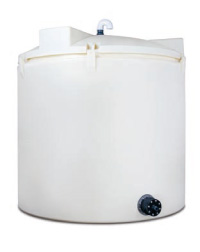Guidelines and Checklist for Proper Tank Design
Proper tank design is crucial to successful safe chemical storage. With over 40 years in the chemical storage industry, we not only offer the tank materials and technologies you need, we also offer the advice that is integral to choosing the right tank, tank materials, fittings and accessories that will properly serve your application.
Because we offer so many options, it is vital to understand why the proper tank configuration is so important to the safety of your employees, the protection of the environment, as well as the protection of your investment.
Let’s take a brief look at some key deciding factors in chemical storage tank system configuration.
Consider the Chemical First
The first thing we’ll ask you when you come to us for a chemical storage application is the chemical you want to store. If the correct tank materials and technologies for a specific chemical are not chosen, very dangerous and costly situations can occur. Choosing a tank based on capacity and size, but not considering tank systems that are built for the specific chemical’s requirements can be catastrophic.
For instance, a linear polyethylene water tank could easily be jeopardized if a toxic chemical such as hydrochloric acid were put in it. In a similar way, you don’t need a tank system designed to withstand the toxic fumes of HCL if you’re storing something like a brine solution. The chemical dictates the tank design, technologies and accessories required.
Choose Your Polyethylene Tank Design and Material
 Once you know what type of tank is required for the chemical you are storing, it’s time to consider your tank design, including the materials and technologies you might need. A SAFE-Tank that offers double walled tank-within-a-tank storage provides 110% containment and is great for sulfuric acid, a chemical that has a hazardous exothermic reaction when exposed to water. It is also important to note that a chemical like sulfuric acid requires an additional anti-oxidant interior tank system, our OR-1000, to meet NSF certification and to prevent oxidative attack.
Once you know what type of tank is required for the chemical you are storing, it’s time to consider your tank design, including the materials and technologies you might need. A SAFE-Tank that offers double walled tank-within-a-tank storage provides 110% containment and is great for sulfuric acid, a chemical that has a hazardous exothermic reaction when exposed to water. It is also important to note that a chemical like sulfuric acid requires an additional anti-oxidant interior tank system, our OR-1000, to meet NSF certification and to prevent oxidative attack.
The chemical dictates the tank style and material, as well as everything else about the tank system.
Choose Your Polyethylene Tank Fittings and Accessories
The type of chemical and the way the tank is filled will determine a lot about the fittings and accessories you choose for your chemical storage application. For instance, if your tank is pneumatically-filled, we recommend a SAFE-Surge Manway Cover or a F.S. 2650 Manway Cover, because these manways provide the venting needed for pneumatically-filled tanks. A chemical that fumes requires a fume-tight manway cover and often a scrubber system to keep harmful fumes from off-gassing chemicals. As for plumbing, there are chemicals corrosive enough that certain valves and connections cause a risk of the chemical leaking or corroding the tank prematurely.
It’s very important to make sure the fittings and accessories you choose for your tank system support the chemical being stored.
Choose Your Chemical Storage Tank Options
Things like tank color and brackets might not seem that important at first thought, but that’s why it’s so important to be able to reference back to the chemical. Chemicals that react to UV exposure require certain tank colors to protect the integrity of the chemical, and some people choose different color tanks for easy identification of chemicals. This is just one example of the many things to think about when choosing your chemical storage system.
To assist you in this venture, we’ve created a clickable checklist that guides you through all of the categories you must consider before identifying the tank that best suits your chemical and specific application.
To learn how to design your tank the right way, check out our Poly Processing Tank Design Checklist
- January 20, 2015
- Topics: Value Added, Tank Design and Materials
About Poly Processing
Posts By Topic
Tech Talk Podcast Episodes
Subscribe By Email
Recent Posts
- Protect Your Facility and Your Bottom Line with a Chemical Leak Detection System
- PPC Installation, Operation, and Maintenance Manual: Ensure Tank Longevity
- How To Use The Chemical Resistance Guide
- Better and Safer Alternatives to Downpipes
- Crosslinked Polyethylene Vs. Fiberglass Reinforced Plastic Tanks
Tank Configurator

Find the recommended tank and system components for your chemical storage challenge.
Configure a Tank Package


